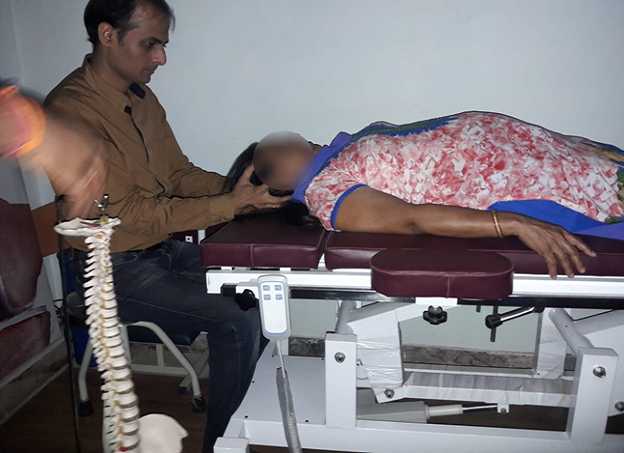What
is Osteopathy?
The
following is a brief descriptor, provided by the Osteopathic Alliance,
summarising what osteopathy is: “Osteopathy is a philosophy of healthcare that
acknowledges that the living body is a self-renewing, self-regenerating,
self-recuperating system which maintains health constantly throughout life.
Whenever that health-maintaining system is compromised, symptoms or disease
could develop. Osteopathy is concerned with that which has compromised health
rather than the resulting condition.
“Osteopaths
have been regulated by statute since 1993. They are trained to diagnose
conventionally and also to use their hands to assess body function and
dysfunction. This gives the osteopath uniquely sensitive information about the
disability within the body and how this insight might be used to help restore
health.
“Although
people commonly describe their symptoms in terms of conventional medical
conditions, osteopaths do not primarily treat medical conditions; they are more
concerned with the cascade of events which could have contributed to the
development of those medical conditions. ” The treatment of Osteopathy is
divided into:
1. Cranial osteopathy.
2. Visceral osteopathy.
What
is Cranial Osteopathy?
Cranial
osteopathy (also called cranial therapy or craniosacral therapy) is not
different to osteopathy, it is the name given to a subtle and refined approach to
osteopathy that follows all the principles of osteopathy, and it is used
throughout the body not just in the head. The name cranial osteopathy simply
refers to the fact that it includes the structures inside the head.
Cranial
osteopaths use a highly developed sense of touch to feel subtle changes of
tension and tissue quality in the living anatomy of the whole body and to
diagnose areas of strain or dysfunction.
The osteopath is often drawn to areas in the
body that have been affected by past events, such as old accidents and
injuries. The body may have learned to compensate for a traumatic event or
injury and the patient may be unaware that there is anything wrong, but the
effects may still be present and relevant to current symptoms.
Diagnosis and treatment are intimately linked
as the osteopath works to activate the innate ability of the body to heal
itself, and by offering gentle and specific support where it is needed to bring
the tissues into a state of balance and release, to restore it to health.
Using this approach, the osteopath learns to
listen to and be guided by the body’s inner knowledge of what is wrong, which
may be different from the patient’s opinion and the osteopath’s opinion. This
helps the osteopath to understand and treat the cause of the symptoms, to
reduce the chance of symptoms returning in the future.
Cranial osteopathy is a gentle, safe and
effective approach to the treatment of a wide range of problems in the whole
body.
A cranial osteopath is trained to diagnose any
strains that are preventing the expression of optimal health. They will gently
help your body’s natural self-healing mechanism to release any unwelcome
strains, enabling a state of health and balance to be restored. This process
can be deeply relaxing and we encourage our patients to take this opportunity
to rest and unwind during treatment.
Cranial
osteopaths treat muscles, ligaments, tendons, fascia, and the nervous and
circulatory systems to facilitate change. Our osteopaths have observed that
cranial osteopathy can assist in the treatment of the following:
·
Neck and Back pain
·
Headaches and Migraines
·
Pregnancy-related aches and pain
·
Sciatica and leg pain
·
Shoulder pain
·
Work Injuries
·
Hip pain
·
Sport Injuries
·
Joint and muscle pain
·
Arthritis
·
TMJ/ Jaw Pain
What
does cranial treatment feel like? What sort of patients or conditions can
be helped with cranial osteopathy?
This approach to osteopathy
is a way of viewing the body rather than a type of technique and it can be used
on every patient. Cranial osteopathy is widely known for the treatment of
babies but, is equally effective for children, adults and the elderly.
In any osteopathic treatment, the whole body is involved and, improvements are
often noted in many different areas. For example, it is not uncommon for digestive
problems to resolve when the spine or pelvis are being treated because of back
pain.
Cranial
osteopathic treatment is very gentle and relaxing. During the treatment, some
people are aware of different sensations, such as mild tension, aching or sensitivity
that gradually disappear, or feelings of warmth and relaxation. Other people
are unaware of anything happening at all during the treatment but are aware
that they feel very different when they get up afterward. Most people become
deeply relaxed during treatment and it is not uncommon for people to fall
asleep.
Visceral
Osteopathy
While Osteopaths predominantly work on the
balance of muscles, bones, ligaments, and tendons, Visceral Osteopaths also
consider the movements and quality of internal organs (also called viscera:
stomach, liver, intestines, lungs, etc..) to treat back, neck, shoulders, and
legs problems.
Importance
of visceral osteopathy
It is definitely an aspect we cannot ignore. All viscera have a strong
physiological role in our health. We absorb the vitamins in the intestines. The
liver detoxifies the body. The pancreas produces the insulin that reduces the
sugar level in our body, etc. Their good function is necessary to the well
being of the human being.
It is also worth mentioning that the internal
organs are exposed and vulnerable to emotions and mental health. Your heart
beats faster when you’re scared. You can experience ‘butterflies’ in the
stomach. Interview or exam stress can make your bowel movements more frequent.
Emotional trauma can also leave their marks on the viscera and affect the
biomechanics around it. Ignoring these aspects would be ignoring what the human
being is made of: a whole simple unit with its emotional and physical sides.
That is why Osteopathy is considered a holistic therapy: we look and treat the
person as a whole, not as parts of the whole.

